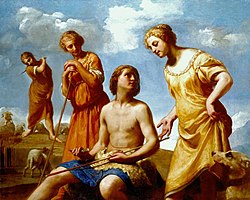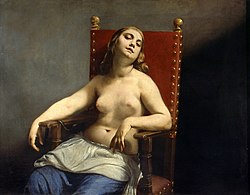| Image | Title | Date | Dimensions | Collection | Medium |
|---|
 | The Virgin and Child with Saints Sebastian, Roch and Hyacinth | c. 1620–1625 | 320 × 190 cm | Oratory of San Rocco, Montegridolfo (Montegridolfo) | Altarpiece [1] |
 | The Procession of the Holy Sacrament | 1627–1628 | | Museum of Saludecio and Blessed Amato (Saludecio) [a] [1] | |
 | The Virgin and Child with Three Carmelite Saints: Teresa of Ávila, Mary Magdalene de' Pazzi, and Andrew Corsini | c. 1629–1631 | 335 × 230 cm | San Giovanni Battista, Rimini (Rimini) | Altarpiece [1] |
 | Infant Jesus between Saints Joseph and Eligius | 1634 | 241.7 × 156 cm | San Michele Arcangelo, Santarcangelo di Romagna (Santarcangelo di Romagna) [b] | Altarpiece [1] |
 | The Penitent Magdalene | 1637 | | Santa Maria Maddalena, Urbania (Urbania) | Altarpiece [1] |
 | Glory of Saint Valerian | 1642–1644 | | Pinacoteca Civica di Forlì (Forlì) [c] [1] | |
 | Glory of Saint Mercurialis | 1642–1643 | | Pinacoteca Civica di Forlì (Forlì) [1] | |
 | Allegory of Human Life | c. 1640s | 118.2 × 95.3 cm | Private collection | Oil on canvas [2] |
 | Allegory of Human Life | c. 1650 | 115 × 94 cm | Cavallini-Sgarbi Collection (Portogruaro) | Oil on canvas [3] |
 | David with the Head of Goliath | c. 1645–1650 | 108.3 × 86.4 cm | J. Paul Getty Museum (Los Angeles) | Oil on canvas [4] |
 | David Holding Goliath's Head | c. 1650 | | Columbia Museum of Art (Columbia, SC) | Oil on canvas [5] |
 | The Rape of Europa | c. 1650 | | Molinari-Pradelli Collection (Castenaso) | |
 | Jacob Peeling the Rods | c. 1650 | 148.8 × 186.5 cm | Picture Gallery, Buckingham Palace (Royal Collection) | Oil on canvas [6] |
 | The Death of Cleopatra | c. 1645–1655 | 95 × 75 cm | Metropolitan Museum of Art (New York City) | Oil on canvas [7] |
 | The Death of Cleopatra | c. 1660–1662 | 45 × 55 cm | Pinacoteca di Brera (Milan) | Oil on canvas [8] |
 | The Death of Cleopatra | c. 1661–1662 | 120 × 158 cm | Kunsthistorisches Museum (Vienna) | Oil on canvas [9] |
 | Emperor Leopold I in Coronation Armour | c. 1657–1658 | 190 × 120 cm | Kunsthistorisches Museum (Vienna) | Oil on canvas [10] |
 | Saint Jerome | after 1659 | 160 × 110.5 cm | Kunsthistorisches Museum (Vienna) | Oil on canvas [11] |
 | The Repentant Magdalene | c. 1660–1663 | 229.2 × 266.1 cm | Norton Simon Museum (Pasadena, CA) | Oil on canvas [12] |
 | Head of a Woman in Left Profile, Looking Down | Undated | 22 × 25.4 cm | Nationalmuseum (Sweden) | Black chalk, heightened with white chalk on dark grey washed paper [13] |
|




















